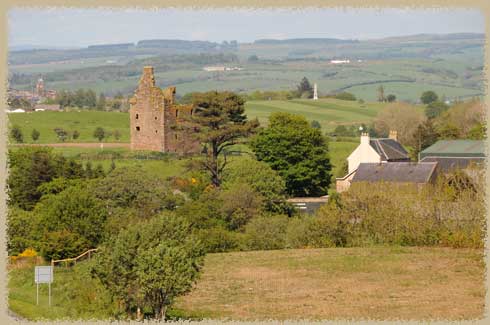Baltersan Castle
Near Crossraguel Abbey is a small, roofless tower house. And cows! And...it's FOR SALE!

the ruins of Baltersan Castle
16th century Tower
I eventually got past the idea that this little towerhouse, sitting a hill overlooking the road and the extremely picturesque ruins of Crossraguel Abbey is for sale, and stopped arguing with Mark about whether we should buy it. Hmph.
The tower is three stories (mostly) with an attic (mostly destroyed). It is a simple L-plan tower built in 1584, with the stair wing capped with a bartizan and a square projecting window. The tower is about 15 m x 8.5m, with a stair wing, with relatively thin walls.
The basement is vaulted, with a kitchen and cellar, although the original walls separating the rooms are long gone.. The main hall is on the next floor and private rooms re above that, reached by a small stair in the angle of the tower. The windows have roll molding on the inner arches, and Salter notes that this is one of the finer examples of its kind in Ayr. THe main staircase is a wide turnpike stair from the main entrane to the main hall. A secondary staircase continues to the third story and attic. 
from crossraguel abbey tower
A rather unique detail of the house are the interior shutters on the third storey (the private rooms). They slide into the thickiness of the walls instead of being placed on the outer surface - a detail that is not seen in other houses until the 18th century.
The castle stood in gardens and orchards (as did most tower houses), although now it sits alone on the top of a small hill. The original estate bordered on the abbey holding.
History - Kennedy Family
A house stood on the lands here (which were leased from the abbey) as late as 1530. This house, owned by the Lord Row, James Kennedy, was replaced by the tower. His neice, by the way, was a mistress of King James IV at the end of the 15th century.
The original tower was built by the Kennedys, on lands they bought from the nearby abbey. It wasn't an easy sell, of course - the Kennedys boiled the abbot in a pot of 'sop' until he signed over the lands. The builder of the castle, David Kennedy, was not a laird, but only a small estate-holder, but his tower contains examples of carving and decoration that are found in much grander houses.
The castle became a holding of Culzean in 1656, which at the time belonged to Alexander Kennedy. It remained in the hands of the Kennedy family until the 1750s, when it is recorded as owend by a sea captain names Arbuthnot.

a closer view of the still-standing tower

